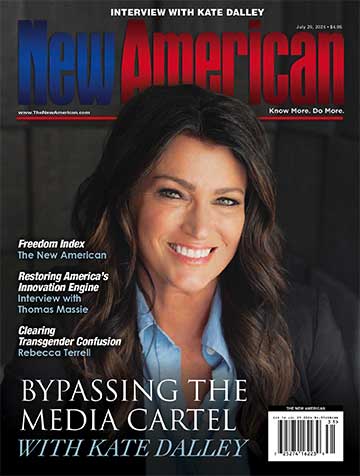
“New research makes it increasingly clear that companies with more diverse workforces perform better financially,” proclaimed McKinsey & Company in 2015. McKinsey’s study was taken seriously, too; in fact, it would be transformational.
Citing McKinsey in 2016, the Harvard Business Review announced, definitively, “Striving to increase workplace diversity is not an empty slogan — it is a good business decision.” Woke capital leviathan BlackRock made McKinsey Exhibit A when making the case for a board-diversity target of 30 percent, Nasdaq and a Securities and Exchange Commission figure touted it when lobbying for policies pressuring companies to embrace diversity, and multitudinous activist groups have done likewise while encouraging various diversity-oriented social-engineering schemes. There’s a problem, however:
The McKinsey study, it turns out, appears to be hogwash.
Not only have no academics been able to replicate it, but, in fact, their efforts have found no correlation at all between corporate diversity and profitability. What’s more, researchers can’t even begin to precisely replicate McKinsey’s research, for a seemingly suspicious reason: The outfit won’t disclose the list of companies it analyzed while conducting it.
But what’s not a secret, now, with diversity dogma having been tested in the marketplace, is that it has “failed,” writes The Wall Street Journal’s James Mackintosh. It’s a false god that hasn’t delivered.
Let’s start with the promise. Showcasing McKinsey’s study, the aforementioned Harvard Business Review wrote in 2016 that companies “in the top quartile for ethnic and racial diversity in management were 35% more likely to have financial returns above their industry mean, and those in the top quartile for gender diversity were 15% more likely to have returns above the industry mean.”
The reality almost a decade on is a bit different, however. A “paper published this year finds that McKinsey’s methodology doesn’t show benefits from diversity for S&P 500 companies for a range of profitability metrics,” relates Mackintosh. There was no link whatsoever.
Then there are the examples of diversity’s failure. Per Mackintosh:
BlackRock and Refinitiv, now part of the London Stock Exchange Group, cited the [McKinsey] study as evidence of financial benefits from diversity when they created an ETF that tracked a diversity index. That index has lagged badly behind since its 2018 launch, returning about 55% against more than 70% for the global index without diversity conditions.
… A similar fund was created earlier by State Street Global Advisors with the ticker SHE. It was promoted through the “Fearless Girl” statue — briefly installed opposite Wall Street’s bronze bull and now opposite the New York Stock Exchange — and backed by research from MSCI, which claimed a 36% higher return on equity for firms with at least three women on the board, or “strong female leadership.”
The reality? “Since its 2016 launch the fund’s return has lagged more than 70 percentage points behind that of the top 1,000 companies,” Mackintosh informs.
Reason, too, exposes diversity dogma’s fallaciousness. After all, if “diversity” were such a money-maker, why wouldn’t more homogeneous and supposedly less-profitable firms hire women and non-whites and reap the rewards?
As Mackintosh related, quoting University of North Carolina accounting professor John Hand, McKinsey’s theory just “seemed implausible because companies would have jumped on it and the advantages would be competed away.”
In fact, as late economist Walter E. Williams often pointed out, it’s government, not the private sector, that has an egregious history of invidious discrimination; this is precisely because, unlike the private sector, it doesn’t pay a financial cost for discriminating.
Williams presented the example of privately owned southern transportation companies that didn’t want to segregate seating racially because they feared offending black customers — but were forced to by government.
Moreover, homogeneity can be an asset. For example, Mackintosh cites research showing that ethnic business groups — such as NY Jewish diamond merchants — benefit from the trust and team spirit their shared background affords. Is this surprising? “United we stand, divided we fall,” anybody?
Mackintosh also points out something I have: The diversity police define “diversity” very narrowly and tendentiously. They emphasize usually superficial diversity such as that relating to race, sex, or sexual behavior. Yet privately educated black and white Harvard Business School graduates might have the same business philosophy, Mackintosh notes — and share thinking much more than either would with an Appalachia-born-and-raised, small-college graduate.
Yet McKinsey doesn’t suggest that companies appoint “worker representatives” to their boards — or perhaps underrepresented, country-raised people from middle America. Why, having the latter could’ve saved Bud Light the destruction of its brand, a fiasco authored by a female Harvard graduate diversity hire.
Speaking of which, the Harvard Business Review cited not just McKinsey, but also a Credit Suisse analysis that allegedly found a corporate diversity/profitability link. But even if there were such a correlation — which, again, apparently doesn’t exist — would it be cause or effect? Would it be that diversity yielded profitability or that profitability led to diversity?
Remember that highly profitable companies grow large, and large companies tend to emphasize diversity. This is not only because they’re perhaps more likely to be targeted by government and media if they’re not “diverse,” but also because they can afford to indulge moral preening and fashionable fancies.
Note, too, the antithesis of the largest business, a multinational corporation, is a family-owned one, which has precious little diversity. Why, not only is everyone usually the same race and ethnicity, but they almost always even share the same last name! Yet as a business grows and opens new offices, it spreads to different areas and perhaps even other nations. Its employees then will, quite incidentally, become more diverse because they’re being drawn from more diverse places.
The problem arises when diversity becomes not an effect but a “cause”; that is, a mission. As to this, McKinsey wrote in its opening line in 2015, “We know intuitively that diversity matters.” It sure does. It can be disastrous.
Examples are the Harvard diversity hires, including ex-president Claudine Gay and a dishonesty researcher, whose corruption damaged the school’s reputation — and really gave it something to review.



